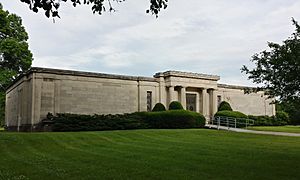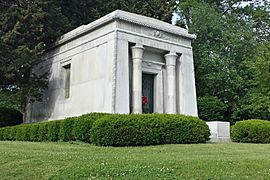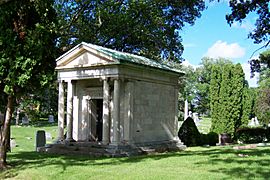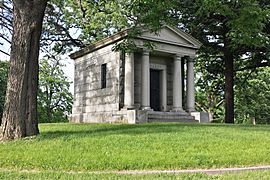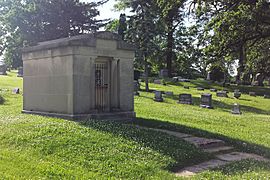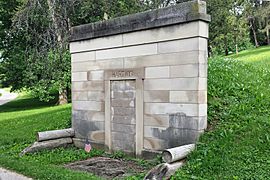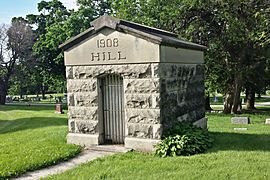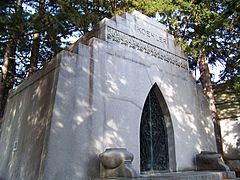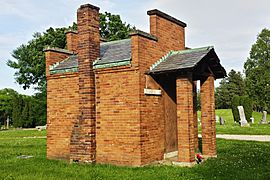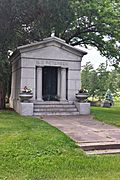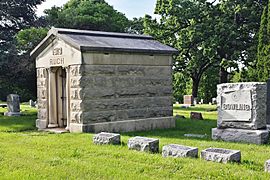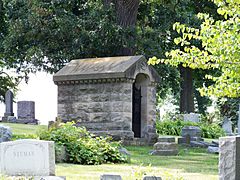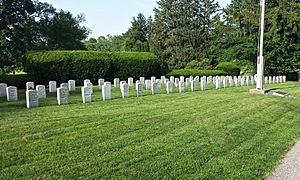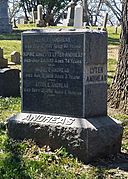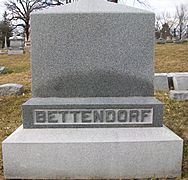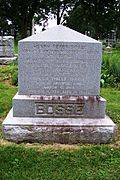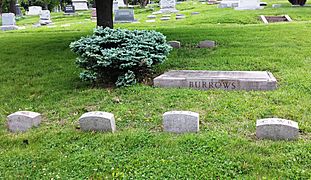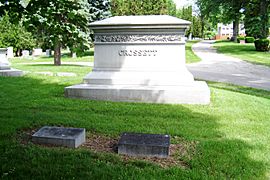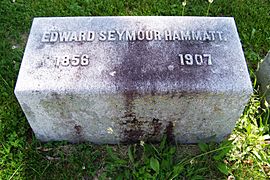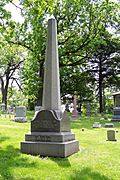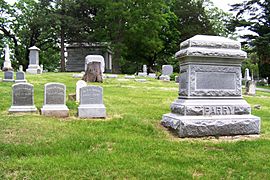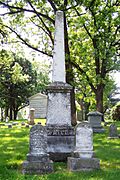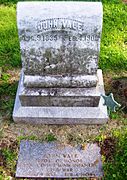Oakdale Memorial Gardens facts for kids
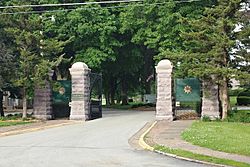
Entrance Gates
|
|
| Details | |
|---|---|
| Established | 1856 |
| Location |
2501 Eastern Ave.
Davenport, Iowa |
| Country | United States |
| Type | Independent |
| Owned by | Oakdale Memorial Gardens |
| Size | 78 acres (32 ha) |
| No. of graves | over 24,000 |
|
Oakdale Cemetery Historic District
|
|
| Architect | George F. de la Roche A. N. Carpenter Clausen & Kruse Israel Hall Edward Hammatt W. H. Kimball Robert H. Nott John W. Ross Seth J. Temple Nathaniel Tunnicliff Philip Tunnicliff Raymond C. Whitaker |
| Architectural style | Art Nouveau Egyptian Revival Gothic Revival Modern Neoclassical Romanesque Revival Richardsonian Romanesque |
| NRHP reference No. | 15000194 |
| Significant dates | |
| Added to NRHP | May 5, 2015 |
Oakdale Memorial Gardens, once known as Oakdale Cemetery, is a special place in Davenport, Iowa. It has a section called "Love of Animals Petland" where pets can be buried. In 2015, this cemetery became a recognized historic district on the National Register of Historic Places. It is also listed on the Network to Freedom. This is a special list from the National Park Service for places connected to the Underground Railroad.
Contents
History of Oakdale Memorial Gardens
Oakdale Memorial Gardens was started in 1856. A group of business people in Davenport created it. They wanted a new cemetery because the old city cemetery was too full. They also wanted an option that was not for profit, unlike Pine Hill Cemetery.
The cemetery was designed by Captain George F. de la Roche. He had also designed Oak Hill Cemetery in Washington, D.C.. Oakdale was planned as a "rural" or "garden" cemetery. This means it was designed to look like a park with beautiful landscapes. Later, it changed to a "landscape-lawn" style. This style focuses more on open grassy areas.
The cemetery covers more than 78 acres (32 ha). The first official burial happened on September 15, 1857. It was for a three-month-old baby named Mary Larned Allen. Some older burials were moved here from the crowded city cemetery.
Oakdale is located across the street from the former Iowa Soldiers' Orphans' Home. Many children who died at the home are buried here. The cemetery also has at least 11 graves of formerly enslaved people. They found freedom through the Underground Railroad. This is why Oakdale is on the Network to Freedom list.
Two special buildings called "receiving vaults" were once in the cemetery. They were used to store bodies during winter when the ground was frozen. A brick vault was built in 1873. A wooden vault was added in 1918. This was needed because many people died during the Spanish flu epidemic.
Architecture and Special Buildings
The main entrance to Oakdale Memorial Gardens has impressive gates. These gates were designed in the Art Nouveau style by architect Edward Hammatt in 1895. They were finished in 1896.
The cemetery also has several private mausoleums. These are special buildings where families can bury their loved ones.
William D. Petersen Mausoleum
William D. Petersen was important in Davenport. His family founded the department store that is now Von Maur. He also helped develop the city's riverfront. His mausoleum was designed in the Gothic Revival style. Architects Rudolph Clausen and Walter Kruse designed it in 1921. Petersen's wife, Sara, wanted a tomb like the ones she saw in Europe. The outside is made of limestone from Greece. Inside, the burial spaces are carved from Greek marble. The ceiling has special ceramic tiles made by the Guastavino Tile Company.
Joseph W. Bettendorf Mausoleum
Joseph W. Bettendorf was a famous industrialist. The city of Bettendorf, Iowa is named after him. His mausoleum was built in 1923. It is designed in the Egyptian Revival style. The outside is made of Barre Granite from Vermont. Inside, the burial spaces are carved from white marble. There are also stained glass windows with Egyptian designs.
Johanna Schricker Mausoleum
This mausoleum was built for Johanna Schricker. She was the wife of Lorenzo Schricker, a lumber business owner in Davenport. Architect John W. Ross designed it in the Neoclassical style. It was built in 1899 by the Vermont Marble Company. The design was inspired by the North Portico of the White House in Washington, D.C. It is made of white marble. The roof is made of bronze.
Soldiers' Lot
Near the center of the cemetery is a special area called the Soldiers' Lot. The U.S. Department of Veterans Affairs takes care of this section.
At one time, 174 soldiers were buried at Oakdale. This included the first Iowans who died in the Civil War at the Battle of Fort Donelson. In 1888, most of these bodies were moved to other national cemeteries. The remaining 14 soldiers' graves were moved to a special plot in 1900. This plot belonged to the Grand Army of the Republic (GAR), a group for Civil War veterans.
In 1940, the GAR plot was given to the cemetery. The next year, the United States government took ownership. Today, the Soldiers' Lot holds the remains of 71 soldiers. They fought in the Civil War and the Spanish–American War.
Notable People Buried Here
Many interesting people are buried at Oakdale Memorial Gardens. Here are a few:
- Alfred T. Andreas (1839–1900), a book publisher and historian.
- Bix Beiderbecke (1903–1931), a famous jazz musician.
- Joseph W. Bettendorf (1864–1933), who helped start the Bettendorf Axel Company. The city of Bettendorf, Iowa is named after him.
- William P. Bettendorf (1857–1910), an inventor and Joseph's brother. He also helped found the Bettendorf Axel Company.
- Henry Peter Bosse (1844–1903), a photographer and engineer.
- Alice Braunlich (1888–1989), a professor who studied ancient languages.
- Frederick G. Clausen (1848–1940), an architect who started the oldest architecture firm in Iowa.
- Rudolph J. Clausen (1878–1961), an architect and Frederick's son.
- John Parsons Cook (1817–1872), who served in the U.S. House of Representatives.
- Eloise Blaine Cram (1896–1957), a zoologist who studied parasites.
- George Henry Cram (1838–1872), a Civil War general.
- Ralph W. Cram (1869–1952), a newspaper editor and early aviator.
- Edward Savage Crossett (1828–1910), a wealthy lumber business owner.
- John Forrest Dillon (1831–1914), a judge famous for "Dillon's Law."
- Nicholas Fejérváry (1811–1895), a Hungarian nobleman. Fejervary Park in Davenport is named after him.
- Alice French (1850–1934), an author who wrote under the name Octave Thanet.
- James Grant (1812–1891), the first president of the Chicago, Rock Island and Pacific Railroad. He was also Speaker of the Iowa House of Representatives.
- Edward Hammatt (1856–1907), an architect who designed the cemetery gates.
- Rebecca J. Keck (1838–1904), a physician and business owner.
- Joseph R. Lane (1858–1931), who served in the U.S. House of Representatives.
- Joseph Bloomfield Leake (1828–1918), a Civil War general.
- Henry Washington Lee (1815–1874), the first bishop of the Episcopal Diocese of Iowa.
- John Fremont McCullough (1871–1963), who helped start Dairy Queen.
- Paul Norton (1909–1984), a watercolor artist.
- Ernest Carl Oberholtzer (1884–1977), an explorer and conservationist.
- Dr. Charles Christopher Parry (1823–1890), a botanist and mountaineer.
- Hiram Price (1814–1901), who served in the U.S. House of Representatives and as U.S. Commissioner of Indian Affairs.
- John W. Ross (1830–1914), an architect.
- Addison Hiatt Sanders (1823–1912), a Civil War general.
- Phebe Sudlow (1831–1922), the first female public school superintendent in the United States. She was also the first female professor at the University of Iowa.
- James Thorington (1816–1887), who served in the U.S. House of Representatives and as a Consul in Colombia.
- John Vale (1835–1909), a Civil War soldier who received the Medal of Honor.
- Charles J. von Maur (1863–1926), who helped found the Von Maur department store chain.




